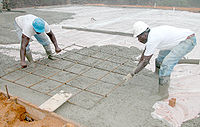
Photo from wikipedia
Potassium-ion batteries (PIBs) are emerging as a powerful alternative to lithium-ion battery systems in large-scale energy storage owing to plentiful resources. Nevertheless, pursuing high-yield anode materials with high initial Coulombic… Click to show full abstract
Potassium-ion batteries (PIBs) are emerging as a powerful alternative to lithium-ion battery systems in large-scale energy storage owing to plentiful resources. Nevertheless, pursuing high-yield anode materials with high initial Coulombic efficiency (ICE) and superior rate capability is still one of the most critical challenges in practical application. Herein, an integrated electrode (PC-x) derived from a petroleum coke precursor (carbon residue rate as high as 89%) is regulated from microstructural engineering to binder optimization devoting to high ICE and efficient potassium storage. Excitingly, with a strong assist from a sodium carboxymethyl cellulose (CMC) binder, the PC-900 anode displays an ultrahigh ICE of 80.5%, one of the highest values reported for PIB carbon anodes. Simultaneously, the PC-900 anode submits a high capacity (304.3 mAh g-1), superb rate (138.2 mAh g-1 at 10C), and excellent stability. Furthermore, the full cell exhibits an outstanding rate and cycling performance (210.7 mAh g-1 at 0.5C), confirming its large-scale application prospects. The ultrahigh ICE and excellent performance are mainly attributable to the beneficial microstructures (low surface area, functional group content, and larger interlayer spacing) created by microstructural engineering. Meanwhile, binder optimization also plays a crucial role in reducing the irreversible capacity and interface impedance, further improving the ICE and rate capability. Importantly, mechanism analysis confirms two-stage K+ storage behavior: reversible adsorption at edges and defects (>0.25 V) and intercalation into crystalline layers (<0.25 V). This work provides an efficient and easily scalable electrode design strategy for future practical applications of PIBs.
Journal Title: ACS applied materials & interfaces
Year Published: 2022
Link to full text (if available)
Share on Social Media: Sign Up to like & get
recommendations!